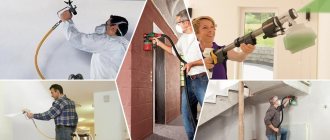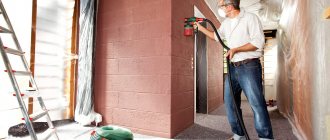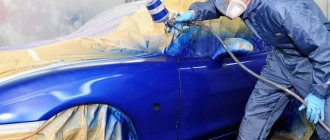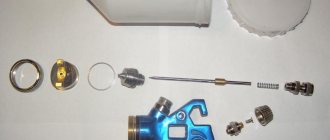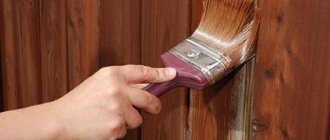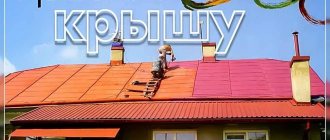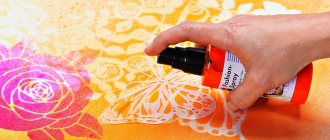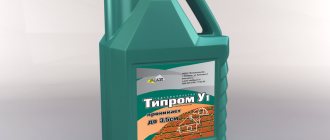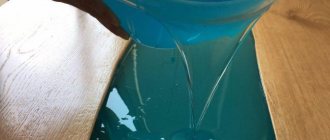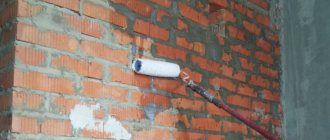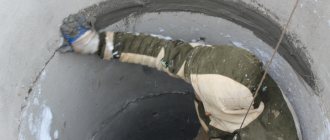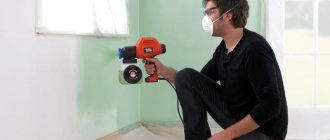Careful owners or car owners, sooner or later, are faced with the task of covering any surface with a thick composition of paint and varnish material or anti-corrosion protection. An ordinary brush will not suit everyone, due to low productivity and relatively low quality of the layer, with streaks and smudges. When overall work efficiency is a priority, attention shifts to a convenient and nimble spray gun. Unfortunately, not every device of this class is capable of spraying compounds with a high viscosity coefficient. Next, we will tell you what types of spray guns can be used to work with anticorrosive materials, glue and thick paintwork materials, and show specific models that have gained a positive reputation in this area.
Types of spray guns for thick compositions
Due to the huge variety of construction tools, finding a device for certain materials and a narrow range of tasks is not a big problem. When choosing a good spray gun for thick compositions, it is important to have a clear understanding of the compositions of what viscosity it will have to work with. First of all, you need to look at the diameter of the nozzle, which should not be less than 2 mm. Spraying methods also play an important role, which we will discuss later.
Air
The most efficient type of spray gun, powered by compressed air supplied from a compressor. Creates a high quality layer and is widely used in auto repair shops and industrial production. The range of tools for this type of spraying is very diverse, and starts from miniature airbrushes, ending with hopper buckets for applying plaster and even cement.
Since we need a spray gun for thick paints, we will limit the viewing range to models with 2-6 mm nozzles, preferably an HVLP (High Volume Low Pressure) system. The compressor performance for such systems should be quite high (300-400 l/min) with an output pressure of 3 atmospheres and a receiver volume of 50 liters. These indicators are quite enough for confident spraying of viscous coatings, stains and anti-corrosion, polyurethane and other compounds.
Pneumatic spray guns for more or less professional work cost around 10,000 rubles, and if you focus on this level, you should pay attention to the following models:
Airless
A simpler type of spray gun that works on the principle of pushing paint out of a nozzle under the action of a pump. The quality of the layer applied by this tool may be inferior to a professional pneumatic one, but it will outperform a roller and brush by the same margin (if there is no experience). Electric airless spray guns are much simpler and cheaper than air spray guns, and are deservedly popular in household and amateur work.
When choosing an airless spray gun, you should focus on the nozzle diameter and power. If you need a workhorse that will last for many years, you should pay attention to manufacturers such as Wagner or Bosh. Cheaper, but slightly less calibrated models can be found from manufacturers HAMMER, Elitech, Enkor.
The lion's share of airless budget spray guns is almost entirely made of Chinese plastic. There is nothing wrong with this, but thick paints, varnishes and glue stick very well to such surfaces, and if they are not removed in a timely manner, they will certainly cause a lot of problems when trying to reuse the tool.
What else to pay attention to
You should also pay attention to the following:
- the weight of the device itself and the weight with the tank fully filled;
- what material the device is made of, plastic is destroyed upon contact with an aggressive environment, so it is better if most of the elements are metal, especially the nozzle;
- availability and composition of the repair kit;
- vibration level, for this purpose several models of the same type are selected, picked up one at a time and turned on;
- presence of an extension cord.
Nozzle size
Some manufacturers indicate in the documentation for the tools which nozzle is suitable for applying materials of different viscosities. The smaller the nozzle diameter, the less paint is consumed and the slower the work progresses. Increasing the size at constant pressure results in less fog formation.
The master selects a nozzle of such a diameter that it is convenient for him to work, focusing on the following recommendations:
- for applying stains – 1.4 mm;
- for base enamels – 1.3-1.4 mm;
- for acrylic enamel and transparent varnishes – 1.4-1.5 mm;
- for filler primers – 1.7-1.8 mm;
- for liquid putties – 2 mm.
The nozzle size for an airless spray gun is selected according to the marking, for example:
- 207 - means 20° spray angle, internal diameter - 0.007 inches (0.18 mm);
- 415 - 40° spray angle, nozzle internal diameter - 0.015 inches (0.38 mm).
Recommended pressure
Pressure power does not determine the quality of the spray gun.
Depending on the operating pressure, there are 3 main types of tools:
- With low pressure (2-2.5 atm). Suitable for liquid and frequently replaced coatings with high quality requirements. They are used in the aviation industry, automotive and furniture production, in the renovation of residential premises, and in everyday life.
- With medium (up to 3 bar, output up to 0.7). Used for finishing high-quality painting of any surfaces.
- With high pressure (up to 56 atm). Suitable for applying viscous coatings, bitumen mastic, and enamel primer. The quality of painting work is low, because... strong pressure does not allow constant flow regulation. It is used in painting booths and in large rooms for treating building facades.
Power for electric models
The power of electric spray guns is 0.5-0.9 kW, lower than that of pneumatic analogues. This parameter is important if you have to work with paints and varnishes of different viscosities. A cheap Chinese spray gun with a compressor power of less than 0.6 kW will be able to spray only the thinnest paint. There are also high-quality models with a power of 0.3-0.5 kW, the efficiency of which is achieved due to a special design.
To work in places where it is difficult to connect to the network (for example, on a roof, when painting a long fence), tools that are powered by a battery are used.
They can operate continuously for up to 30 minutes and differ from mains-powered devices in the following characteristics:
- their power is less;
- weight is greater (due to the built-in battery);
- the cost is higher.
The power of the built-in compressor is indicated on the packaging of the tool.
Paint tank material and dimensions
Spray gun tanks are made:
- made of plastic - transparent, which allows you to control the consumption of paintwork materials, but they are difficult to wash after work;
- made of metal - easy to clean, but if heavier metal rather than aluminum is used, this can additionally strain the painter’s hands.
The smallest paint tank holds 150 ml. Containers with a volume of up to 600 ml are placed in the upper part of the device. The tanks located below are larger. They hold 700-1000 ml of paintwork and are suitable for repairing garages, fences, ceilings and apartment walls.
The largest tanks with a volume of 10-13 liters have painting stations used on construction sites.
Receiver volume
Different types of compressors for painting are equipped with receivers of unequal volume:
- household (garage) piston and single-cylinder ones have an air tank volume of 20-25 l;
- semi-professional - 50-100 l;
- professional – from 200 l.
The presence of a receiver is typical for remote compressors.
Device performance
The parameter depends on the type of spray gun. Z
and in 1 hour of work you can paint:
- manual spray gun – 150-200 m²;
- electric – 240-260 m²;
- pneumatic – when working with paints – up to 400 m², with putties – up to 85 m².
Spray gun for applying glue
The connection of all kinds of materials over a large area requires a very uniform adhesive layer. Typically, a glue spray gun is used in the furniture industry to reliably connect foam to wood, leather, fabric and other materials. For such tasks, the most optimal is a pneumatic spray gun with an upper tank, capable of creating the most even layer of adhesive. The range of suitable models and prices varies significantly, but for household and semi-professional work almost any gun with a 1.7 mm nozzle is suitable.
When choosing a pneumatic spray gun for applying glue, it is recommended to consider models with an LVLP (Low Volume, Low Pressure) spray system, which has the least fogging during operation and the greatest transfer of material to the surface. Make sure the nozzle and needle are made of brass or steel to resist corrosion.
If models with a stationary compressor are not suitable, you can consider an electric spray gun with a remote compressor. It is desirable that the pistol body be made of metal, like the next model.
Types of electric spray guns
An electric paint sprayer is considered a home version of the device; for continuous operation, pneumatic guns are used as standard. However, there are semi-professional devices on sale that can also be used by specialists at work. They are distinguished by increased power and the ability to choose a dense type of enamels.
There are several types of electrosprayers, differing in functionality and the resulting painting quality:
- Air-based, the compartment for the dye can be located in different areas: above, below or with a special pump. The order of paint distribution is determined by the structure of the device; spraying occurs from air pressure. Getting a beautiful and thin layer of paint is considered a plus. However, during operation, foggy particles are released, increasing the consumption of the composition;
- Airless, application is carried out by high pressure. The device consists of a nozzle for supplying the product and a hose with high pressure. Suitable for compounds with high viscosity. During operation, no cloud distribution is formed; it is selected for processing large areas and protective preparations. The downside is the difficulty of obtaining a beautiful layer;
- The manual paint sprayer is distinguished by its versatility and can be used for any job. The device includes: a gun, a paint reservoir, a pump, a compressor. The gun and the pump can be installed not next to each other, then the problem with noisy and vibration operation is eliminated;
- The painting station is considered a professional tool, with increased power and good performance. The device includes a pump with increased power and a motor. They are located in a separate case, the weight of such a tool is large, and wheels are attached to facilitate use. Spraying occurs from a gun that is connected to a hose. There are different functions.
An electric paint sprayer is considered a home version of the device; for continuous operation, pneumatic guns are used as standard.
Walther Pilot III glue gun - K
Pneumatic spray gun for various types of adhesives, made of stainless steel coated with Teflon, which prevents glue from sticking to the body of the gun.
A special adhesive rotary nozzle mixes air with the material with force, which ensures easy, high-quality spraying of thick adhesives.
The absence of side holes on the air cap forms a round torch and prevents glue clumps from clogging in the holes.
The tool works the entire shift without cleaning.
The air cap can also have side holes for low-viscosity adhesive materials to form a wide spray.
The advantage of the sprayer design is the absence of rubber gaskets.
The high resistance of the tool to the chemical effects of solvent-based adhesives, many years of service life without the need for repairs, and the industrial purpose of the sprayer have made this sprayer model very popular among furniture manufacturers and in the automotive industry.
The pistol comes with standard 1.5mm or 1.8mm nozzles.
Walther Pilot LDG pressure tank
Thin-walled, lightweight stainless steel tanks (1.4571).
The lid opens easily and quickly thanks to the cross-shaped screws.
Walther Pilot pressure tanks are manufactured in accordance with Directive 97/23/EC.
The following tank options are possible:
- LDG 5 (5 liters)
- LDG 10 (10 liters)
- LDG 20 (20 liters)
Equipment options:
- without stirrer
- with manual stirrer
- mixer with oil-free air motor
- stirrer with electric motor
Maximum operating pressure 6 Bar.
